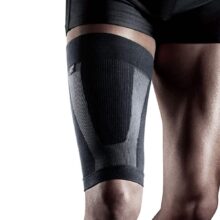Groin Wrap
In Stock

Hamstring injuries are prevalent and hold significant importance in the field of sports medicine. The hamstrings are a group of muscles located on the back of the thigh that play a crucial role in leg movement, especially in activities involving running, jumping, and explosive movements.
Understanding the importance of hamstring injuries, their impact on athletes, and implementing appropriate prevention and treatment strategies are essential for optimizing performance and reducing the risk of reoccurrence.
This article aims to highlight the significance of hamstring injuries in sports medicine.
Hamstring injuries are among the most common injuries in sports, particularly in activities that involve sprinting, kicking, or sudden changes in direction. These injuries can have a substantial impact on an athlete’s ability to perform, affecting speed, agility, power, and overall athletic performance.
Hamstring injuries can be challenging to manage and often require a lengthy recovery period. The healing process can be slow due to limited blood supply to the area, resulting in a prolonged absence from training and competition. Consequently, athletes may experience setbacks in skill development and conditioning.
Hamstring injuries have a high recurrence rate, with reinjury being a common concern. Without proper rehabilitation and preventive measures, athletes who have previously suffered from a hamstring injury are at increased risk of experiencing another episode. This emphasizes the need for comprehensive rehabilitation and ongoing prevention strategies.
Hamstring injuries can occur due to a variety of factors, including muscle imbalances, inadequate warm-up, poor flexibility, fatigue, overuse, and previous injury. Understanding these risk factors and addressing them through preventive measures can significantly reduce the likelihood of hamstring injuries.
Accurate diagnosis of hamstring injuries is crucial for effective management and rehabilitation. The diagnostic process may involve:
Gathering information about the onset, mechanism of injury, and symptoms is important. A physical examination is conducted to assess the severity of the injury, identify the location of pain or tenderness, and evaluate the range of motion and strength of the affected leg.
Diagnostic imaging, such as magnetic resonance imaging (MRI) or ultrasound, may be ordered to assess the extent of the injury, identify muscle fiber tears, and determine the severity of tissue damage.
Functional assessments, such as hop tests, agility drills, or isokinetic strength testing, may be performed to evaluate an athlete’s readiness to return to sport and to track progress during rehabilitation.
The treatment approach for hamstring injuries may vary depending on the severity of the injury but commonly includes:
Initial management involves rest, avoiding activities that aggravate the injury, and protecting the injured hamstring from further damage. Crutches or a brace may be recommended to offload the injured leg during the acute phase.
The use of rest, ice, compression, and elevation (RICE) helps reduce pain, swelling, and inflammation in the early stages of the injury.
A structured rehabilitation program is essential for hamstring injury recovery. This includes exercises to restore range of motion, strengthen the hamstring muscles, improve flexibility, and address any underlying muscle imbalances or weaknesses. Modalities such as heat, electrical stimulation, and manual therapy techniques may also be incorporated.
Athletes must progress through a step-by-step return-to-sport protocol under the guidance of a healthcare professional. This gradual process ensures the hamstring is adequately healed, and the athlete has regained sufficient strength, flexibility, and functional ability to prevent reinjury.
Implementing preventive measures is crucial to reduce the risk of future hamstring injuries. This includes proper warm-up exercises, regular stretching routines, strengthening exercises targeting the hamstrings and surrounding muscles, and addressing any biomechanical or training errors.
Hamstring injuries are of great importance in sports medicine due to their prevalence, impact on performance, prolonged recovery time, and high recurrence rate. Proper diagnosis, treatment, and rehabilitation are essential for optimal recovery and minimizing the risk of reinjury.
Athletes, coaches, and sports medicine professionals should prioritize implementing comprehensive prevention strategies to reduce the occurrence of hamstring injuries. By emphasizing appropriate warm-up routines, targeted strengthening exercises, and ongoing monitoring, athletes can enhance their performance, minimize downtime, and maximize their potential while reducing the risk of future hamstring injuries.

In Stock


In Stock
The LP EmbioZ Thigh Power Sleeve with Silicone features a Power System that improves the lower extremity kinetic chain, from the thigh to the knee, to stabilize knee movement and to prevent over twisting. It also increases proprioception, and enhances the effectiveness of reproduction and accuracy of knee movement.